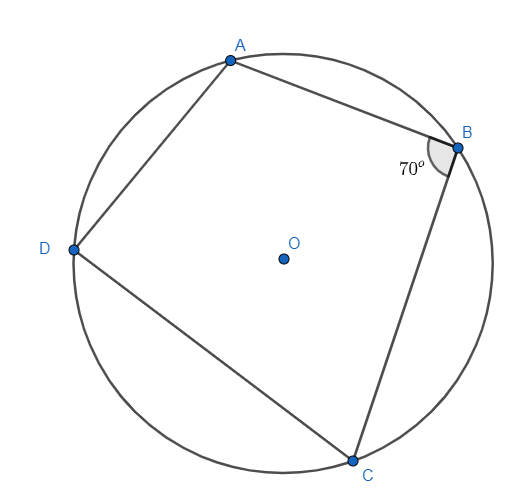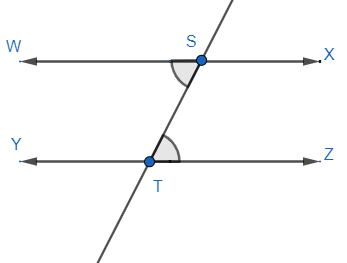Answer
423k+ views
Hint: Property of cyclic quadrilaterals can be given as “sum of opposite angles in cyclic quadrilateral will always be${{180}^{\circ }}$“. And can be given as “sum of angles formed by a transversal on the same side of two parallel lines is ${{180}^{\circ }}$“.
“Complete step-by-step answer:”
Here, we have a cyclic quadrilateral ABCD, with $AB||CD$ and $\angle B$ and hence, we need to determine the remaining angles of quadrilateral ABCD i.e. $\angle C,\angle A,\angle D$. First of all, let us draw a neat diagram with the help of given information:

As we know cyclic quadrilateral lies in a circle and all vertices of it will touch the circumference of the circle. So, here ABCD is lying inside a circle with $\angle B={{70}^{\circ }}$ , O as a centre and $AB||CD$ .
Here, we need to use two properties to solve this problem, first property of cyclic quadrilateral and second of parallel lines.
The property of a cyclic quadrilateral is, the sum of opposite angles of any cyclic quadrilateral is ${{180}^{\circ }}$ . Hence, from the given diagram we get,
$\begin{align}
& \angle B+\angle D={{180}^{\circ }}............\left( i \right) \\
& \angle A+\angle C={{180}^{\circ }}............\left( ii \right) \\
\end{align}$
Now, another property of parallel lines can be given as that sum of angles on the side of a transversal to two parallel lines is ${{180}^{\circ }}$ . Transversal is a line which cuts two parallel lines.

So, from the above property we have,
$\angle WST+\angle STY={{180}^{\circ }}$ and $\angle XST+\angle STZ={{180}^{\circ }}$
Hence, AD and BC are acting as a transversal for parallel lines AB and CD.
So, we can get equation from the cyclic quadrilateral ABCD as
$\begin{align}
& \angle A+\angle D={{180}^{\circ }}............\left( iii \right) \\
& \angle B+\angle C={{180}^{\circ }}............\left( iv \right) \\
\end{align}$
As we know the value of $\angle B$ is given in the problem as $\angle B={{70}^{\circ }}$ . Hence, put it in equation (i) to get $\angle D$ , so we get,
$\begin{align}
& {{70}^{\circ }}+\angle D={{180}^{\circ }} \\
& \angle D={{180}^{\circ }}-{{70}^{\circ }} \\
& \angle D={{110}^{\circ }} \\
\end{align}$
Now, put $\angle B=70$ in equation (iv) to get the value of $\angle C$ . So, we get
$\begin{align}
& {{70}^{\circ }}+\angle C={{180}^{\circ }} \\
& \angle C={{180}^{\circ }}-{{70}^{\circ }} \\
& \angle C={{110}^{\circ }} \\
\end{align}$
Now, $\angle A$ is remaining, so let us put value of $\angle C={{110}^{\circ }}$ in the equation (ii) to get $\angle A$ .8 Hence, we get
$\begin{align}
& \angle A+{{110}^{\circ }}={{180}^{\circ }} \\
& \angle A={{180}^{\circ }}-{{110}^{\circ }} \\
& \angle A={{70}^{\circ }} \\
\end{align}$
Hence, all the angles of cyclic quadrilateral can be given as $\angle A={{70}^{\circ }},\angle B={{70}^{\circ }},\angle C={{110}^{\circ }},\angle D={{110}^{\circ }}$
Note: One may try to apply only one property he or she may know only one property i.e. property of cyclic quadrilateral or property of parallel lines. One cannot get answers by using only one property of them. So, be clean with the both properties mentioned in the solution.
One may try to apply the property of a simple quadrilateral as that sum of all interior angles is ${{360}^{\circ }}$ of it. It will not work here to get values of all the angles.
“Complete step-by-step answer:”
Here, we have a cyclic quadrilateral ABCD, with $AB||CD$ and $\angle B$ and hence, we need to determine the remaining angles of quadrilateral ABCD i.e. $\angle C,\angle A,\angle D$. First of all, let us draw a neat diagram with the help of given information:

As we know cyclic quadrilateral lies in a circle and all vertices of it will touch the circumference of the circle. So, here ABCD is lying inside a circle with $\angle B={{70}^{\circ }}$ , O as a centre and $AB||CD$ .
Here, we need to use two properties to solve this problem, first property of cyclic quadrilateral and second of parallel lines.
The property of a cyclic quadrilateral is, the sum of opposite angles of any cyclic quadrilateral is ${{180}^{\circ }}$ . Hence, from the given diagram we get,
$\begin{align}
& \angle B+\angle D={{180}^{\circ }}............\left( i \right) \\
& \angle A+\angle C={{180}^{\circ }}............\left( ii \right) \\
\end{align}$
Now, another property of parallel lines can be given as that sum of angles on the side of a transversal to two parallel lines is ${{180}^{\circ }}$ . Transversal is a line which cuts two parallel lines.

So, from the above property we have,
$\angle WST+\angle STY={{180}^{\circ }}$ and $\angle XST+\angle STZ={{180}^{\circ }}$
Hence, AD and BC are acting as a transversal for parallel lines AB and CD.
So, we can get equation from the cyclic quadrilateral ABCD as
$\begin{align}
& \angle A+\angle D={{180}^{\circ }}............\left( iii \right) \\
& \angle B+\angle C={{180}^{\circ }}............\left( iv \right) \\
\end{align}$
As we know the value of $\angle B$ is given in the problem as $\angle B={{70}^{\circ }}$ . Hence, put it in equation (i) to get $\angle D$ , so we get,
$\begin{align}
& {{70}^{\circ }}+\angle D={{180}^{\circ }} \\
& \angle D={{180}^{\circ }}-{{70}^{\circ }} \\
& \angle D={{110}^{\circ }} \\
\end{align}$
Now, put $\angle B=70$ in equation (iv) to get the value of $\angle C$ . So, we get
$\begin{align}
& {{70}^{\circ }}+\angle C={{180}^{\circ }} \\
& \angle C={{180}^{\circ }}-{{70}^{\circ }} \\
& \angle C={{110}^{\circ }} \\
\end{align}$
Now, $\angle A$ is remaining, so let us put value of $\angle C={{110}^{\circ }}$ in the equation (ii) to get $\angle A$ .8 Hence, we get
$\begin{align}
& \angle A+{{110}^{\circ }}={{180}^{\circ }} \\
& \angle A={{180}^{\circ }}-{{110}^{\circ }} \\
& \angle A={{70}^{\circ }} \\
\end{align}$
Hence, all the angles of cyclic quadrilateral can be given as $\angle A={{70}^{\circ }},\angle B={{70}^{\circ }},\angle C={{110}^{\circ }},\angle D={{110}^{\circ }}$
Note: One may try to apply only one property he or she may know only one property i.e. property of cyclic quadrilateral or property of parallel lines. One cannot get answers by using only one property of them. So, be clean with the both properties mentioned in the solution.
One may try to apply the property of a simple quadrilateral as that sum of all interior angles is ${{360}^{\circ }}$ of it. It will not work here to get values of all the angles.
Recently Updated Pages
Assertion The resistivity of a semiconductor increases class 13 physics CBSE

The Equation xxx + 2 is Satisfied when x is Equal to Class 10 Maths

How do you arrange NH4 + BF3 H2O C2H2 in increasing class 11 chemistry CBSE

Is H mCT and q mCT the same thing If so which is more class 11 chemistry CBSE

What are the possible quantum number for the last outermost class 11 chemistry CBSE

Is C2 paramagnetic or diamagnetic class 11 chemistry CBSE

Trending doubts
Difference Between Plant Cell and Animal Cell

Difference between Prokaryotic cell and Eukaryotic class 11 biology CBSE

Fill the blanks with the suitable prepositions 1 The class 9 english CBSE

Change the following sentences into negative and interrogative class 10 english CBSE

Summary of the poem Where the Mind is Without Fear class 8 english CBSE

Give 10 examples for herbs , shrubs , climbers , creepers

Write an application to the principal requesting five class 10 english CBSE

What organs are located on the left side of your body class 11 biology CBSE

What is the z value for a 90 95 and 99 percent confidence class 11 maths CBSE



